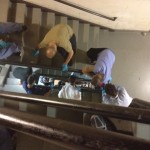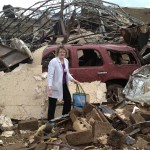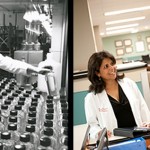
Barbara Poe takes a break in the medication area of the Heart to Heart International’s mobile medication unit. Photo courtesy of Nina Morris.
BARBARA POE NO LONGER WORKS as the lead pharmacist at 45-bed Moore Medical Center in Oklahoma. A tornado destroyed the building on May 20. But in the days that followed, the Norman Regional Health System employee volunteered at one of the mobile medical units in Moore and scheduled other volunteer pharmacy personnel to assist.
The response to her two e-mails requesting volunteers to work six-hour shifts was overwhelming, Poe said. So was the flatbed truck with 18 pallets of donations from a small hospital in Nebraska where the pharmacy director decided to take action.
“We are so grateful for all of the people who supported us,” Poe said. “I mean it is just truly heartwarming.”
A Group Effort
Kansas-based Heart to Heart International, a relief organization, had its mobile medical unit in Moore by 1 a.m. on May 21, Poe said.
One of the organization’s personnel contacted Norman Regional for pharmaceuticals, Poe said. By the midday of May 23, she and Darin Smith, the assistant director for pharmacy services and performance improvement, had delivered albuterol inhalers, ceftriaxone injection, and other pharmaceutical items. She had also ordered additional pharmaceuticals for a return trip the next day.
Poe, after that first visit to the mobile medical unit, said she “may ultimately end up doing some volunteer work.”
What caught her interest in the mobile medical unit was a small area at one end. It had an under-the-counter refrigerator and shelves with bins of medications. She said a pharmacist from a local community pharmacy happened to be onsite.
Poe said the unit’s volunteers “jumped” at the idea of her arranging to have a pharmacist onsite for all the hours the medical clinic operates.
With that approval, Poe said later, she e-mailed the president of the Oklahoma Society of Health-System Pharmacists and the executive director of the Oklahoma Pharmacists Association “just asking for volunteers.” Her intent was to have two six-hour shifts per day—8 a.m. to 2 p.m. and 2 to 8 p.m.—with each shift staffed by two pharmacists or a pharmacist and a pharmacy technician.
She estimated that 50–60 pharmacists from all over the state volunteered to work at least one shift.
A Personal Crusade
One of those volunteers was Chelsea Church, the 2010–11 president of the Oklahoma Society and now the Oklahoma State Board of Pharmacy’s pharmacist compliance officer for the southwestern region.
“It was personal,” Church said of her volunteer work on May 30.
She and her husband formerly lived in Moore and her husband still works there. Church said a former house of theirs was severely damaged by the May 20 tornado.
So when Smith e-mailed on the morning of May 30 asking if she could fill in for someone who had canceled, Church said, she took a vacation day to help out.
Church said she dispensed about 10 prescription medications—mostly antiinfectives for wounds and corticosteroids for rashes—and filled syringes with tetanus vaccine.
When no pharmacist was present in the mobile medical unit, she learned, patients received prescriptions to take to a community pharmacy.
The mobile medical unit stocked maintenance medications, such as antidepressants, antihypertensive agents, and diabetes treatments, for people who had lost their supplies in the disaster, Church said.
But most of the patients, she said, actually were out-of-the-area people who had come to Moore to help clear the debris. They came to the mobile medical unit after stepping on rusty nails or otherwise hurting themselves while helping others.
Poe estimated that Norman Regional Hospital had sent at least 1000 doses, perhaps 1500, of tetanus vaccine to the mobile medical unit in the first 10 days after its arrival.
“I know the hospital has been hit financially,” she said, “but whatever they’ve needed to shore up this [mobile medical] clinic, the hospital has just said, ‘Go do it.’”
Poe said one pharmacist who showed up unexpectedly at the mobile medical unit wanted to help even though there was no room for a third pharmacist.
This pharmacist, Poe said, asked about administering vaccines in the field and walked to the building of the nearby county health department, but she learned that it lacked tetanus vaccine.
“So, we supplied 150 doses of tetanus vaccine for her to go out into the field with one of the teams that [the health department] was sending out,” Poe said.
Feeling Compelled to Help
Another unexpected arrival, she said, was the pallets of donations that a flatbed truck delivered to Norman Regional Hospital.
Rachel Forster, pharmacy director at 25-bed Sidney Regional Medical Center in Nebraska, said The Weather Channel’s footage on Moore after the tornado struck her emotionally.
“I just felt compelled that we had to do something to help,” she said.
It was the everyday person in Moore, Forster said, for whom she felt compassion. “What do you do when everything you have is gone?”
Fortunately for her, she said, the pharmacy had recently expanded to “24-7-365” service through the hiring of direct employees. There were now two day-shift pharmacists, two night-shift pharmacists, and a full-time pharmacy technician in addition to Forster.
On obtaining approvals from her supervisor, chief financial officer, and chief operating officer and e-mailing Poe and Smith, Forster said she made appeals for donations of tangibles on the radio and in the local newspaper.
Forster said she used her local connections in the community of roughly 6000 to arrange the logistics. Sidney-based Adams Industries Inc. agreed to provide a flatbed truck and driver. A local farm implements company, 21st Century Equipment Inc., donated 18 pallets, shrink-wrap, and a location to store the donations.
“We kind of challenged the community to make it a success,” she said. “And everybody here wanted to do something.”
Forster said the first donation was toys from a Sidney Regional employee’s five-year-old granddaughter who was told that the images of Moore on television meant the community’s children no longer had toys of their own.
The donations, Forster said, ran the gamut of things that Sidney residents thought they would need quickly if they lost their home.
Poe, when interviewed by happenstance several hours after the arrival of the truck from Sidney, said “I about passed out.” She had imagined four or five boxes that could fit in the SUV that is substituting for her own, which was destroyed in the tornado while in the parking lot at Moore Medical Center.
Heart to Heart’s mobile medical unit left Moore on June 2, said Dan Weinbaum, director of communications. The county health department at that time took over operations from the relief organization whose personnel and volunteers, he said, function as “early responders.”
As of May 30, according to Smith, Norman Regional’s pharmacy personnel had donated $1000 and the pharmacy had received $500 from the Oklahoma Society of Health-System Pharmacists and $1800 from elsewhere to cover the costs of medications in the relief effort in Moore.
—By Cheryl A. Thompson
Editor’s Note: This article, which was originally published in the online version of the American Journal of Health-System Pharmacy, is reprinted with permission.








 If you want to contribute tutorials, news or other stuff please contact us. We pay 150 for each approved article.
If you want to contribute tutorials, news or other stuff please contact us. We pay 150 for each approved article. Consectetur adipisicing elit. Sed do eiusmod tempor incididunt ut labore.
Consectetur adipisicing elit. Sed do eiusmod tempor incididunt ut labore. This site uses valid HTML and CSS. All content Copyright © 2010 Newscast, Inc
This site uses valid HTML and CSS. All content Copyright © 2010 Newscast, Inc If you like what we do, please don't hestitate and subscribe to our
If you like what we do, please don't hestitate and subscribe to our